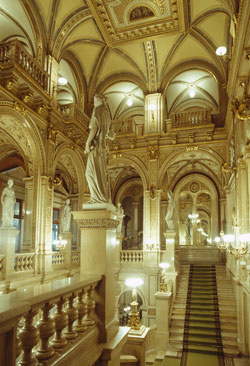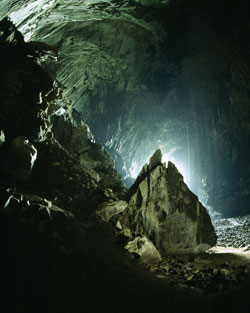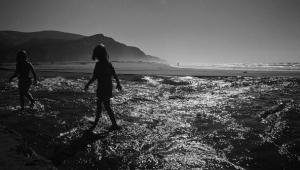Gaining Access: Ask And You Might Just Succeed
Let me give you a few personal examples where I was able to get permission to take the pictures I wanted, and let this serve as an inspiration to you in your travels. Let me say at the beginning that in all of these situations, my name in the photographic industry meant nothing. The people I spoke to didn’t know me, they didn’t know my work, and, to be honest they couldn’t care less. Everything is dependent on your approach, your timing, the mood of the person you are talking to, and serendipity.
Keukenhof Gardens
The most beautiful gardens in the world are just outside of Amsterdam. In late April when the tulips are blooming, they get literally millions of people visiting, photographing, and enjoying the incredible display. Keukenhof Gardens consists of 80 acres of manicured perfection. I didn’t even see a weed, and I was looking for one!
When the place opens at 8am, bus loads of tourists start pouring in. That means that landscape photography like you see in (#1) becomes impossible because of all the people. All you can do, then, is macro work and patterns of color. This is nice, but to be able to show the beauty of a large section of the gardens means that you’ll get the best possible images. Therefore, I contacted the office by e-mail and asked if a photo group could enter earlier. Much to my delight, they said yes, they do this all the time. I arranged to have my group arrive at 6am where the friendly staff gave us an orientation as well as coffee and tea, and after paying the entrance fee we enjoyed two hours of fantastic photography before the hordes arrived.

All Photos © 2010, Jim Zuckerman, All Rights Reserved
Another advantage of arriving early is that there is a better chance of overcast weather and/or fog. For floral photography, that’s the best case scenario.
Baptistry Doors, Florence, Italy
When I visited Florence, I wanted to get a perfect shot of the famous doors on the Baptistry. It is covered in scenes from the Bible, and I think it’s one of the most beautiful doors in the world. What I saw, though, was less than ideal. There is a gate that keeps people back a few feet to protect the door (#2), and while it doesn’t ruin the picture completely, it’s not what I wanted. I wondered to myself how this gate could be opened, and I noticed that there is a cut in the cement at the base of the gate where it could apparently be lowered. I asked a security officer nearby if the gate could ever be removed, allowing for a photograph, and he directed me to an office two blocks away and told me to ask the person in charge.

I walked to the office and explained that I was a photographer from America and I’d love to get a clean shot of the door. The manager said to me, “When would you like to do this?” I said, “How about tomorrow morning, at 7 o’clock?” He replied, “Okay.” Just like that. Needless to say, I was surprised at my good fortune.
The next morning two officers were there because it required two keys to lower the gate. Now that I had permission, the two men kept other tourists from walking in front of my camera! It was great (#3). To keep the vertical lines of the door parallel with the edges of the frame, I moved back about 30 ft and used a medium telephoto lens.

Vienna Opera House
The opera house in Vienna is classically beautiful. The entry is a three-story marble structure, and the theater itself is dazzling. I went to a performance and tried to get some pictures, but of course no tripods were allowed and that meant that a high ISO was needed. I wasn’t happy with that. In addition, no photos were allowed. Therefore, I went to the ticket office and asked to whom I could speak to get permission to take pictures when the opera house was empty.
The next day I walked a couple of blocks away to the office and spoke to the person in charge. This time, I was told the fee would be $100 to shoot the interior, and I agreed because it would be a real treat to have complete access to such a stunning interior. I spent an hour and a half photographing the lobby and the theater—with a tripod—and the theater people turned all the lights on for me. It was awesome. The picture of the interior of the theater (#4) was taken from the stage, and the amazing lobby (#5) looks great with all the lights turned on.


Taj Mahal
No tripods are allowed on the grounds of the Taj Mahal, and in order to get permission to bring one in, you must contact the Ministry of Antiquities in New Delhi. To be honest, you really don’t need a tripod to shoot successfully. However, there will always be certain compositions that require one. For example, in the picture through the arch (#6), I wanted the archway itself plus the tomb in the background to be in focus, and that required a small lens aperture that in turn required a tripod.

Instead of trying to negotiate the Indian bureaucracy myself, I asked the tour company I use in India to do it for me. No fee was required, but the application for permission had to be done at least four months in advance. Once we had permission, the document was presented to the security people at the Taj and I was able to bring a tripod on the grounds.
In India, you must be very specific as to where the tripod may be used and for how long. If this detail is addressed, you’ll have no problems in using a tripod to get the best possible pictures.
Mulu National Park, Malaysian Borneo
In coresponding via e-mail with the director of a national park in the Borneo portion of Malaysia, I found out that in one of the spectacular caves—the Deer Cave—tripods were not allowed. This seemed pretty strange to me, but then I’m used to nonsensical policies coming from bureaucracies. After several e-mails back and forth, the director agreed to let me use a tripod inside the cave. He just arbitrarily agreed. I told him I was coming from halfway around the world to shoot the cave, and I’d really appreciate if he could deviate from the rules, so he said Okay.
It turns out the cave is massive (several 747 aircraft could fit inside), and I was the only one there. Good pictures would have been impossible without a tripod (#7).

Twin Towers, Pre-9/11
It pays to always be on the lookout for photo opportunities and to have your photographic antennae alert. I was in New York doing a stock shoot in the early 90’s, and I took the typical shot of the Brooklyn Bridge in the foreground with lower Manhattan in the background. Everyone used to take that picture, but I really wanted something different. I looked around and thought how great it would be if I could get permission to get on top of one of the nearby buildings for an elevated view of the bridge and the skyline of New York.
While I was shooting from ground level, a woman walked up to me and asked what I was doing. She had an interest in photography and was curious about my Mamiya RZ 67 medium format film camera. I explained what stock photography is, and then I told her it would be so amazing if I could get on top of that building over there—and I pointed to the best case scenario rooftop. I was shocked when she told me that she knew the man who owned it! I asked if she would call him and ask if we could go up there, she did and he said yes. I couldn’t believe it. In a city of 8 million people, the chances of this happening are, well, 8 million to one.
We gained access not to the roof but to an upper floor with a window that could open, and I was happily shooting the beautiful scene when a red tug boat just happened to pass under the bridge (#8).












































